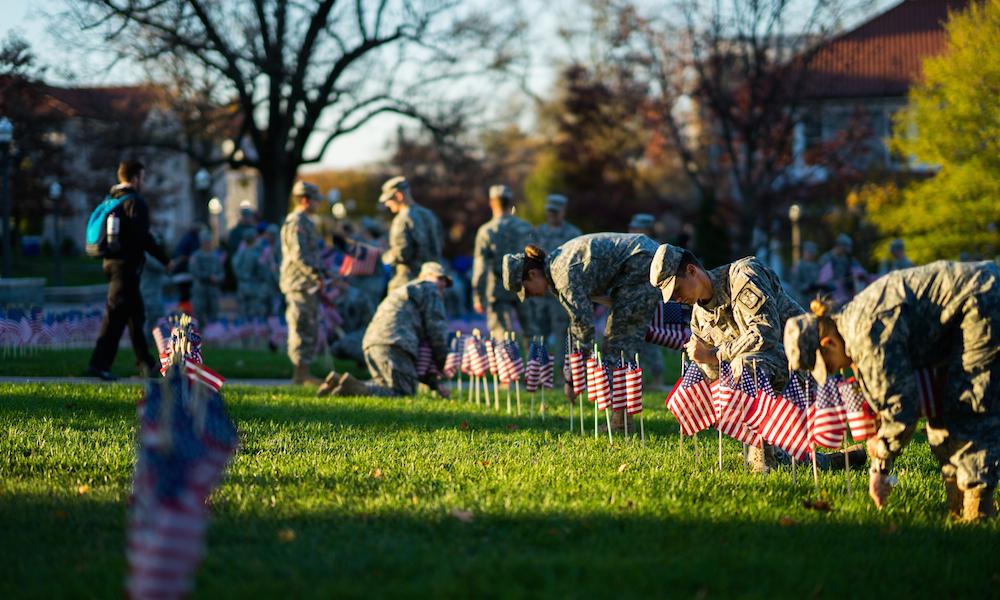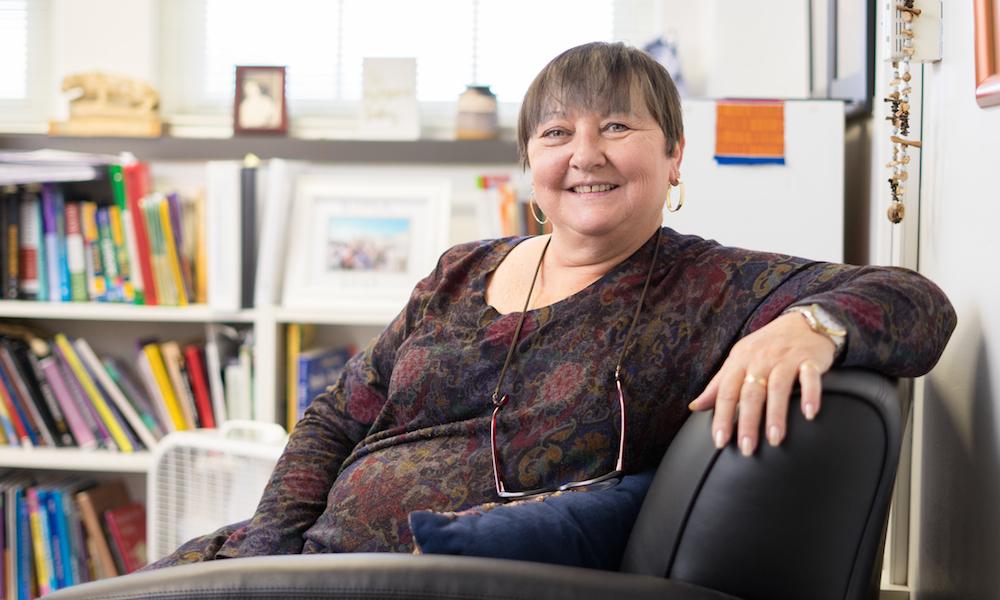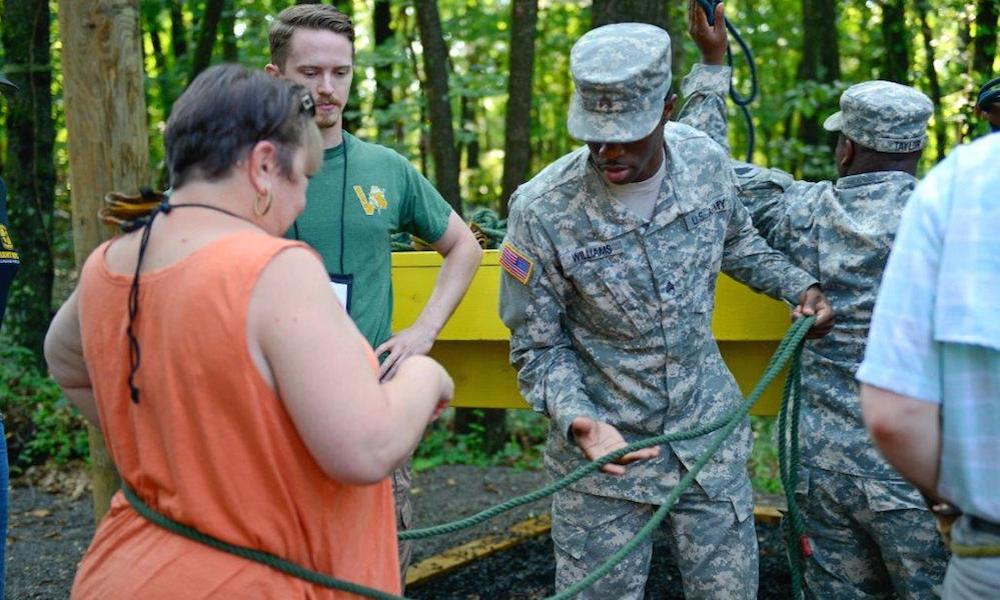How to think, not what to think
Civilian and military realms partner to develop leadership among JMU students
Arts and Culture
SUMMARY: Striking similarities exist between civilian and military leadership training at JMU. "In the military, we're very mission oriented," says student Clint Roberts. "Here are JMU, our mission is to set the example as both a model leader and student."
From Winter 2017 Madison magazine
Three years ago, two JMU leadership development professionals—one from the military world, the other a civilian—came together to consult on a mission ordered by the U.S. Army Cadet Command.
Lt. Col. Richard Showalter, then head of the university’s Department of Military Science, reached out to his College of Education colleague Cheryl Beverly, a professor of learning, technology and leadership education—and a proud Army brat—to better understand the mission to integrate student-centered learning in the ROTC curriculum. “At JMU, they were already doing it,” she says. “It is interesting to observe how we’re doing the same things, just calling them different things.”
“So much of what the military does is informed by research and prior experience, as well as reflecting, deconstructing, analyzing and evaluating current experience to prepare for the next mission,” Beverly says. “That’s what we want in our student teachers. I see the crossovers so much.”
Having pre-service teachers reflect on their performance during field placements, for example, invites critical reflection, Beverly says, by asking questions such as “What was the goal?” “What did you do that did and did not work?” “What would you do differently?”—reflections that, she says, are similar to the components of an after-action review in military circles.
 |
| Cheryl Beverly, professor of learning, technology and leadership education, draws from her Army brat years and her academic experience to help develop future leaders. |
“Junior leaders have to make decisions to affect the outcome of a mission,” says Lt. Col. Tom Tolman, military science head and professor. To prepare them for eventual roles as active-duty soldiers or members of the Reserve or National Guard, the Army ROTC curriculum has moved from a command-and-control model to a mission-command model. “That’s where a leader communicates well, expresses their commander’s intent, their vision and what they want accomplished,” Tolman says. “It does not necessarily include how to do what needs to be done.”
By combining classroom instruction, such as case studies of mission-command scenarios, with experiential leadership training in the field, the curriculum is designed for cadets to learn by doing. “We try to learn through history and through progressive leadership development,” Tolman says. Cadets learn about strategy by researching battles and tactics, which they then teach to their fellow students. Through physical training, field training exercises and team-building activities, cadets take responsibility for mentoring younger students to achieve required levels of abilities and endurance.
|
“So much of what the military does is informed by research and prior experience, as well as reflecting, deconstructing, analyzing and evaluating current experience to prepare for the next mission. That’s what we want in our student teachers. I see the crossovers so much.” — Cheryl Beverly, professor of learning, technology and leadership education |
Cadet Terrence Smith, Duke Battalion commander, models ROTC training in developing leadership in his subordinate company commanders. “I explain the why or the purpose of an order, not just ‘do it,’” he says.
For veterans who enter undergraduate studies at JMU, military training and experience—no matter which branch they served in—affect their college experience, as well as that of their fellow students and faculty members.
Political science professor Jennifer Taylor, whose husband is a Navy veteran, has observed that JMU students who are veterans of military service offer “a seasoned perspective” in the classroom. They are often not as quick to jump to a conclusion or a position during class discussion, she says. “I’ve also witnessed a huge sense of personal and civic responsibility pervasive among veterans.”
Indeed, when student veterans—many of whom are older than the average undergraduate student—saw the need for a place on campus to study and meet, they sought administrative support that led to the opening of the Center for Student Veterans in 2015.
Clint Roberts, a senior majoring in psychology, views the center as an important place for veterans to call home between classes and to build connections among themselves. An Army combat medic and now vice president of JMU’s Student Veterans Association, Roberts says the student-managed space offers a catalyst for veterans to serve each other as they engage in studying, tutoring sessions and meetings.
“In the military, we’re very mission oriented,” Roberts says. “Here at JMU, our mission is to set the example as both a model leader and student.”
Beyond supporting each other, Roberts believes student veterans are helpful classmates for JMU students in general. “We’re an example of leadership in the classroom,” he says. “We tend to speak up more, and this practice enriches the college experience by starting conversations in the classroom.”
 |
| Cheryl Beverly trains with ROTC cadets at Fort Knox in summer 2016. |
Nick Swayne, executive director of 4-VA, learning, technology and leadership education professor and military science head and professor from 2001 to 2006, served for 26 years in the Army. He concurs with Roberts that veterans’ rich life experiences are an asset for fellow students and faculty members.
In the academic arena, there is a tendency to teach the theory of leadership as a behavioral science, he says. The military’s more hands-on approach “is possible to integrate in an academic setting, but you have to work at it,” Swayne says.
In teaching a leadership and organizations course, Swayne struggled with incorporating a hands-on experience. He introduced FIRST LEGO League as that component by assigning students to coordinate specific functional areas for the competition that draws 4,000 people annually to campus. “They are doing what they’ve been taught,” he says of his students’ engagement.
“The military does a really good job of teaching you how to see, how to problem-solve and how to adapt as you’re going,” Beverly says. “Those skills that build confidence, resilience and communication are important for professional development, no matter what your role in life is.”
# # #
